
しばらく連載の稿を離れていましたが、仕事の方はやや小康してきたので
ふたたび「日本列島37,000年史」に復帰したいと思います。
歴史と住空間の相関文化史という視点でしょうか。
37,000年というのは日本列島に人類痕跡が確認される最初期からの時間。
最終氷期の最寒期後(19,000年前)から温暖化・海水準上昇=縄文海進があり、
16,000年前頃から日本では縄文時代が始まる。
この海水準上昇は約120メートルにおよんだ(年速1–2cm)。
ピーク時である約6,500年〜約6,000年前まで上昇が続いたと言われている。
おおまかには日本列島人類史は、旧石器と縄文以降に2分される。
上の図は縄文を象徴する「土器」文化のアジア圏での分布。
縄文海進によって同時期に各文化圏で同時に土器文化が花開く。
あ、図は先般来触れてきたように最新の国立歴史民俗博物館展示からです。
こういう図を見せられるといかに縄文海進のインパクトが凄まじいか、
如実に示されていると思います。
大陸では大型陸生動物のハンティングは生業として維持できたかも知れないが
動物相が大きく変化しただろう日本列島社会では
動物性タンパク獲得は主に魚類に限定されるようになったのだろうと思います。
前回まで触れたように陸生動物ハンティングによってもたらされた
知恵の基本原理に対してそれに上乗せするように魚類獲得の知恵が加わった。
日本人的思考法の基底刷り込みにこの思考文脈は大きかったに違いない。
陸生動物の動態観察と海生魚類の動態解明には違いがあるでしょう。
海には海流があり、それに連動して魚種が変化する。
その生態をよく研究していくことで漁獲に大きな差が生まれただろう。
また、カツオの1本釣りなど漁撈方法も魚種に合わせて発展した。
こういう思考法が人間の社会ルール構築にも影響したように思える。
現代の日本人の思考法の特徴にはこの要素が大きいのではないかと推測。


一方で大陸社会との交流ということも人類知の獲得のような意味で
きわめて目的的に追究されただろうことも容易に想像される。
中国大陸では漁業は伝統的に大きく育たなかったと司馬遼太郎の記述で読んだ。
どうも遠浅の東シナ海では獲得できる魚種が限られ味覚発展があまりなかったのか、
たとえばフカヒレのような高級食材は日本からの輸入専一だったとされる。
またコンブも日本北方産のものが珍重されていたとされる。
その分、2大大河の存在という条件によって農業文化が基盤になり
農業文化の特徴として支配と被支配の関係性が強調される文化を生んだ。
暦という農業の基本要素に基づいて自然の表現のための文字文化が起こり
やがて歴史として刻印されていく交流が東アジア世界で始まっていく。
こんな視点でそうした基盤になった縄文の世を考えて見たい。
English version⬇
From the Paleolithic to the Jomon Era: The 37,000-Year History of the Japanese Archipelago – 11
The human history of the Japanese archipelago is divided into two parts: the Paleolithic period and the Jomon period and beyond. The Jomon and post-Jomon periods are divided into two parts: the Paleolithic and the post-Jomon periods. The Jomon period was also a time of knowledge.
I have been away from writing serial articles for a while, but now that there has been a lull in my work, I would like to return to the “37,000 Year History of the Japanese Islands” again.
I would like to return to the “37,000 Year History of the Japanese Islands” again.
I would like to return to the “37,000 Year History of the Japanese Archipelago” from the viewpoint of a correlated cultural history of history and living space.
37,000 years is the time since the first traces of humans were found in the Japanese archipelago.
After the coldest period of the last glacial period (19,000 years ago), there was global warming and sea-level rise (Jomon sea-level rise).
The Jomon Period began in Japan around 16,000 years ago.
This sea-level rise was about 120 meters (1-2 cm/year).
The rise is said to have continued until its peak about 6,500 to 6,000 years ago.
The human history of the Japanese archipelago can be roughly divided into Paleolithic and post-Jomon periods.
The figure above shows the distribution of “earthenware” culture, which symbolizes the Jomon, in the Asian region.
The Jomon culture flourished simultaneously in each cultural area during the same period of time.
As mentioned earlier, this figure is from the latest exhibit at the National Museum of Japanese History.
This figure shows the tremendous impact of the Jomon sea advance.
I think it really shows how great the impact of the Jomon sea advance was.
On the continent, hunting large terrestrial animals could have been maintained as a livelihood, but the fauna would have changed drastically.
In the Japanese archipelago, where the fauna would have changed drastically, the acquisition of animal protein was mainly done by fish.
I believe that the acquisition of animal protein is now mainly limited to fish.
As previously mentioned, the basic principle of wisdom brought about by terrestrial animal hunting
The wisdom of acquiring fish was added on top of the basic principle of wisdom brought about by hunting of terrestrial animals, as I mentioned in the previous article.
This context of thinking must have been a major part of the basic imprinting of the Japanese way of thinking.
There must be a difference between observing the dynamics of terrestrial animals and elucidating the dynamics of marine fishes.
The ocean has currents, and fish species change in tandem with the currents.
A good study of their ecology would have made a big difference in the catch.
In addition, fishing methods, such as single-line fishing for skipjack, developed in accordance with the species of fish.
This way of thinking seems to have influenced the construction of human social rules.
I believe that this element may be a major characteristic of the modern Japanese way of thinking.
On the other hand, it is easy to imagine that exchange with continental societies
On the other hand, it is easy to imagine that exchange with continental societies would have been pursued with great purpose, in the sense of acquiring human knowledge.
I read in Ryotaro Shiba’s book that the fishing industry did not traditionally grow in mainland China.
I wonder if the East China Sea, with its shallow waters, did not allow for much development of taste in the species of fish that could be acquired there.
For example, it is said that luxury foodstuffs such as shark’s fin were exclusively imported from Japan.
Kelp from the northern part of Japan is also said to have been highly prized.
The existence of two major rivers in the area led to the development of an agricultural culture, which was characterized by the domination and subjugation of the people.
This culture emphasized the relationship between the dominant and the subjugated as a characteristic of the agricultural culture.
Based on the calendar, the basic element of agriculture, a written culture arose to express nature.
Eventually, the East Asian world began to interact with each other in a way that is etched in history.
I would like to consider the Jomon period as the basis for such a culture.
Posted on 11月 11th, 2022 by 三木 奎吾
Filed under: 日本社会・文化研究, 歴史探訪







コメントを投稿
「※誹謗中傷や、悪意のある書き込み、営利目的などのコメントを防ぐために、投稿された全てのコメントは一時的に保留されますのでご了承ください。」
You must be logged in to post a comment.